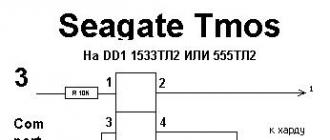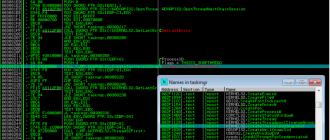The latest gaming industry news signals that world giants are closely looking at the "clouds". Recently, Microsoft officially announced the development of the DeLorean system, a game streaming technology that can predict the actions of gamers before pressing the keys of a keyboard or gamepad. Apparently, the company is preparing to submit its own streaming service, which will allow launching games for the Xbox One and Xbox 360 via a browser. This means that in a few years, when the technology is optimized, Sony will have a serious competitor with their PlayStation Now.
There were rumors that Google bought the platform and hired engineers from CiiNOW, who launched the cloud game service from the major operator Korea Telekom (KT). Official confirmation of the acquisition has not yet been, but experts are talking about the appearance on the market of a new major player.
The number of companies offering streaming games is growing worldwide. Before turning to the review, let's remember how the technology of streaming games.
So, cloud technology, or video streaming technology of games, allows you to start the game without installing anything, but only by connecting to a remote server using a browser. The user starts a game on his device, the program sends a signal to the server, authorizes it, selects the best server in the cloud for the user.
Each image that the game builds is captured, compressed into a video stream and sent to the client application, which only needs to display it to the user. As you can see, everything is simple: the game starts on the server, and the user receives only a video stream of 5-10 Mbit / s.
And now about how cloud gaming services are presented in the global market.
America
The company OnLive can rightly be called the pioneer in the field of cloud games. The first mention of OnLive takes us back to 2003. But the public announcement took place only in 2009 - at the GDC exhibition in San Francisco. OnLive promised console for $ 100, not more, and in some cases, and $ 50. They have fulfilled their promise. In 2011, I myself bought such a prefix on their website for $ 99.
During 2010-2011, OnLive signed contracts with major publishers of PC games: Square Enix, THQ, Ubisoft, Warner, CD Project. However, publishers are not in a hurry to give their new products to the cloud technology. At the same time, skeptic comments from copyright holders, in particular, Crytek, claim that they “do not believe in the success of cloud games” are starting to appear, because the existing networks of operators are not prepared for Сloud Gaming, so it’s worth waiting until 2013-2015 ( It seems that the time of the "clouds" has come).
In February 2012, OnLive reports about attracting an investment of $ 40 million from the largest manufacturer of electronic equipment HTC. Attracting copyright holders, Onlive simultaneously launches an application for Smart TV.
And suddenly, like a bolt from the blue, the news is heard on August 23, 2012: OnLive is recognized as an insolvent company with debts of $ 30-40 million. The company is changing its shareholder, Lauder Partners LLC becomes the new owner under the leadership of Gary Lauder - well-known in the gaming industry of venture capitalist .
Once at the September conference of Cloud Gaming USA, at dinner, a company of young people joined us, and Gary was among them. Who would have thought that the guy is the managing partner of a foundation that owns and manages OnLive. Today OnLive has changed the business model, has gone on to integrate with Steam and is trying to restart its product in a new concept.
Asia
Almost simultaneously with OnLive, Gaikai appeared on the market, its founder - David Perry, a well-known personality in the gaming industry, the ideologist of a number of games, including MDK, Earthworm Jim, Messiah.
In 2012, Sony, which until then had harshly criticized OnLive, acquires Gaikai for $ 380 million to develop its own streaming service, PlayStation Now. It allows you to broadcast games not only on the PlayStation 4, PlayStation 3 and PlayStation Vita, but also on TVs, tablets and smartphones. The service was officially introduced in January 2014, and at the same time the company launched its closed testing in the United States. In July, an open beta was launched for Americans, and the platform will come to Europe in 2015.
Koreans CiiNOW first launched gaming streaming service in KT (Korean Telekom). It seems not particularly successful, judging by the minimum marketing activities. The number of users has barely exceeded 5,000 real paying customers. The company provided the service and how the White Label solution for telecom operators. Any operator could use their corporate colors and logo using the CiiNOW platform.
In the summer of 2014, this company ceased to exist, recognizing the impossibility of recouping its costs. According to unofficial data, it was partially acquired by Google. Indirect confirmation - the status of key employees in social networks: for example, Devendra Rauth, VP of Engineering at CiiNOW, has moved to the position of Tech Biz Dev in Google.
Europe
In Europe, cloud services are represented by companies such as G-cluster Global and Playcast. The first - the leader in profitability in the world of "cloud" games. Finns launched the project in 2000, focusing on cooperation with the world's largest IPTV operators - Orange (France), SFR (France), NTT Plala (Japan), Cox (USA). We do not yet observe our own services in Smart TV and PC.
The service of the Israeli company Playcast Media System was announced on July 21, 2009, and on the same day its pilot launch began. Playcast concentrated on large screens and launched its service on Amazon Fire TV on OUYA set-top boxes.
Russia
Well, in Russia, the game in the clouds took the company Playkey.
Since 2012, we have been developing the playkey.net platform, which has been open for beta testing since June. Our servers are located in Moscow and Perm. Every day about 5 thousand unique users play on the service. 60% of users play from Russia, 25% from Ukraine, there are users from Belarus, Kazakhstan, Latvia, Romania, Azerbaijan, Georgia, Lithuania, Moldova. I am glad that the session time is constantly growing, and already averages 35 minutes.
Our audience is not hardcore. Playkey was created for those who do not want or do not have the opportunity to invest a lot of money in gaming entertainment. 80% of our audience is young people under the age of 25, mostly schoolchildren and students. In the future, we will also attract a family audience, those who play from time to time for entertainment. In this regard, we count on users of digital cable TV. So, we are already in the final stage of integrating our gaming service into the prefix "Dom.ru TV" of the second generation.
In addition to a large catalog of games, another competitive advantage to which we aspire is cross-platform. The service already works on Windows and MacOS, in 2015 we plan to connect Linux and Android. We are also developing our own PlaykeyBox, which can be played on the big screen.
Games in the cloud go to a new level. Videocards AMD RadeonSky Series ™ allows you to fully play in the cloud. Due to the performance, quality and latency of AMD video cards Radeon series Sky with AMD SKY technology makes cloud game providers make PC and gaming console quality games available on any device.
High density performance
AMD Radeon ™ Sky Series graphics cards can simultaneously support up to six game streams in HD quality 1. With the AMD Radeon ™ Sky Series, cloud game service providers will be able to expand their existing infrastructure and resources and support even more game streams, from simple to the most demanding AAA games. AMD Radeon ™ Sky Series video cards support a wide range of server systems.
High quality multiplayer stream
A single AMD Radeon ™ Sky Series graphics card can support up to six game streams in HD resolution (720p) without sacrificing quality. Each of the six streams can operate in up to 30 frames / sec. By reducing network latency, users can play their favorite games in HD quality (720p) without losing gaming performance. AMD Radeon ™ Sky Series video cards also support 1080p gaming.
The Advantage of AMD Radeon ™ Graphics Cards
Increase the settings, increase the resolution and play the best games on best equipment. Gamers will be able to play in the cloud on any device and anywhere and at the same time receive the same gaming experience with AMD Radeon ™ as on their PCs or game consoles. Get the full experience of the latest DirectX® 11.1 games and take advantage of AMD’s unique features, such as TressFX Hair (the world's first realistic hair creation system that makes game characters more like real people).
aMD RapidFire Technology
The AMD RapidFire Software Development Kit “The Secret Ingredient” is an elusive quality that makes something unusual or special. It is difficult to name him, but if you see, you will immediately understand. When it comes to the AMD Radeon ™ Sky Series graphics card for playing in the cloud, our secret ingredient is the AMD RapidFire software development kit.
AMD SKY's unique technology feature — AMD RapidFire Software Development Kit — makes it easy to use AMD's independent embedded H.264 encoder. Some AMD Radeon ™ Sky graphics cards can simultaneously encode multiple H.264 streams in different resolutions and different qualities without significantly reducing the performance of the graphics processor. The AMD RapidFire development tools package helps independent software developers optimize data coding paths to reduce latency and includes certain predefined installations to minimize integration efforts and reduce development time. In addition, AMD RapidFire simplifies the configuration of key hardware parameters, such as resolution, frame rate, and data transfer rate, to minimize network bandwidth, while ensuring high image clarity.
Using the AMD RapidFire development tools package, cloud service providers and middleware vendors for cloud gaming can seamlessly transfer both the latest AAA games and the simplest games to the most diverse user devices over the Internet. AMD RapidFire provides flexibility when streaming multiple games in HD resolution. As a result, the user on almost any device (including a smartphone, a Smart TV, a tablet, a laptop, and a desktop PC) can play like on a game console. The undoubted advantage is the launch of the consolidated data center of the optimal number of games per graphics processor.
Special features
Architecture Graphics Core Next (GCN)
For the first time, the GCN architecture is represented in a 28-nm graphics processor designed to create unsurpassed gaming sensations and is designed to be best graphics card in the world.
High performance, high density streaming
WITH aMD video card Radeon ™ Sky Series service providers for the game in the cloud can simultaneously support up to six game streams per graphics processor 1, which allows you to increase free space in data centers.
DirectX® 11.1 support
DirectX® 11.1 - the last word in high-speed and high-quality games and calculations. Thanks to technologies such as compute shaders, Direct3D, multi-threaded rendering and tessellation, DirectX® 11.1 not only improves the quality of the image in games, but also uses all the features and performance improvements found in Windows 8.
With all this technology OnLive were advanced. The developers have created a system that worked stably, without problems on the user side with good communication.
After bankruptcy, all OnLive patents and assets were sold to the investment company Lauder Partners, and then the OnLive service was restarted, but with a new team.
The last effort to gain a foothold in the market was the service CloudLift, which offered modern games from Steam and the instantaneous continuation of an interrupted game session on another device. Just before closing, OnLive even started offering the CloudLift Enterprise option: streaming business applications on low-power devices for large corporations and enterprises.
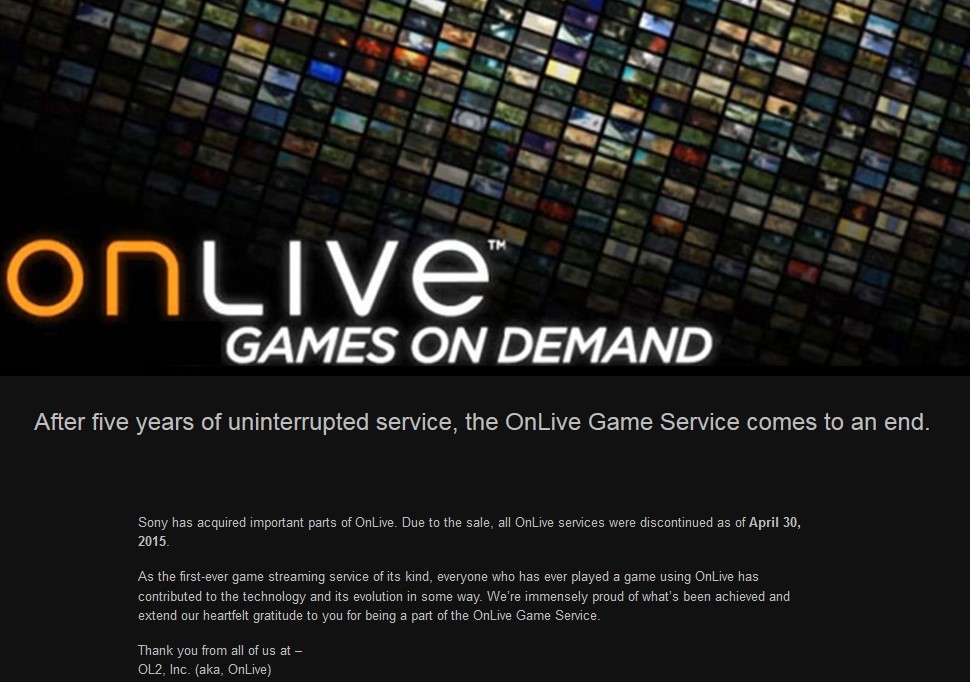
Screenshot from OnLive website with termination information
However, all this did not help, and in 2015, the company announced the sale of all Sony patents and the termination of activities.
Gaikai success
Gaikai was also announced at Game Developers Conference 2009. The company was going to do it later, but the OnLive announcement at GDC 2009 forced the company to take a second step.
Screenshot from Gaikai website
On July 1, 2009, Gaikai founder David Perry published Gaikai data and a demo video on his personal blog. Some games were shown on the video, including Mario Kart 64 and World of Warcraft running in a browser window. Perry stated: “We developed this [meaning - Gaikai] for the real Internet. We do not declare that we have 5,000 pages with patents, it did not take us seven years, and we do not declare that we developed a specialized hardware chip for encoding with a one-millisecond delay. As you can see, we do not need all this, and therefore our expenses will be much less. ”
On the same day, GameSpot published an interview with David Perry, in which the latter spoke about the Gaikai service, its differences with OnLive, its relationship with publishers, and its business model. Unlike OnLive, the company did not try to sell cloud services to the end user. Instead, it provided a platform for computer games makers, where players could try out demo versions of the latest innovations for free.
As Perry told OnLive in an interview, “They plan to fight Sony, Microsoft and Nintendo at the same time, which will be a daunting task.” In addition, they will have to use an expensive marketing strategy to attract players. And even if they can do it, they can take away only a certain share of the market from Nintendo, Sony or Microsoft. ”
As history has shown, this approach worked, and in 2012 it was announced the sale of the service for $ 380 million to Sony. In 2012, OnLive and Gaikai companies had similar technologies. For example, you can see a detailed comparison of the work of these 2 services on the example of several games.
Cloud game services today
On the Wikipedia page there are a couple of dozen services, active and already deceased. Let us try to understand this apparent abundance. I dropped the already inactive projects, as well as projects that related to streaming files. As a result, the list of projects for review has been significantly reduced. The rest were divided into 3 parts: existing commercial projects for PC, projects for set-top boxes and TV, and small projects.Commercial PC Projects
▍LiquidSky
The founder of the service is a young 23-year-old Ian McLoughlin. The service itself is in beta testing, which does not prevent it from having more than 500,000 users worldwide today. In September 2016, the service received an investment of $ 4,000,000 from a group of investors. Read more about this. LiquidSky service is built on Nvidia GRID technology.
Screenshot of LiquidSky Virtual Desktop
This service is interesting primarily because the Liquidsky service itself does not matter what you do in this cloud. A typical situation is when players, using this service and having an account on Steam, quickly download any previously acquired game to a remote server, launch it and play for fun, being saved in Steam itself. At the same time paying a monthly subscription for $ 14.99, users receive in addition 500 GB for storing data on the server. If you look at Dropbox, which asks for $ 8.25 for 1 TB of data, it doesn't seem that expensive. The subscription limit is 80 hours per month.

Screenshot from LiquidSky website
This service appeared quite recently and at the time of its appearance had a huge number of bugs. Since the service is quite active in social networks and the Internet, you can see what kind of flaws the service has at the moment. A few months ago, for example, when I logged into my account, I noticed that the cursor was randomly moving around the screen, and I could hardly control its movement. When I finally went to my library of games on Steam, I noticed that there were other games there. It turns out that I got into someone else's account and we with the owner of this account struggled to control the cursor, which explained his strange behavior.
▍Playkey
The service itself is a Russian project, also built on the basis of Nvidia Grid. The implementation of the project creation idea began in 2012, and throughout 2014 the service was in open beta testing mode. At the turn of 2014-2015. The project has reached the release stage by launching into commerce.On their website there is a list of games that the user can play. When paying a monthly subscription for 590 rubles. The user gets access to 150 free games on the service and gets the opportunity to buy some paid games and play them on Playkey. Subscription limit is 70 hours per month.
The project is local, which automatically protects it from other competitors. However, the original service did not go. You can read more about this in the article.

Screenshot from Playkey
According to Playkey CEO Yegor Guryev, in May 2015 the number of paying users was only 282 people. However, the company managed to rectify the situation by changing the business model. As of March 2016, the service had 200,000 registered, 10,000 subscribed and 4,000 regularly paying users. To change the situation, the following changes were made to the company's activities:
- Changed the business model - “At the first stage, we had a subscription, buying which, the user got access to 120+ games, but in this way we could not get new items from developers and offered old content, .... Values in this collection, users have seen the minimum. The games that are available at low cost for sales, many have not passed once and at the same time worked well on computers that have been upgraded 1-2 years ago. The developers did not allow new content to be subscribed, and it’s understandable why - they were afraid of losing revenues from selling games at retail, while receiving absolutely unpredictable subscription revenues. We launched a piece of content purchase and the ability to play games that were purchased earlier. This gave us access to new products that occupy 85% of the demand. At the same time, we transformed the subscription to the games catalog (from which we refused), into payment for using our server capacities. By current indicators, we see that on average, a user plays on Playkey 20 hours per month. ”
- Rebuilt marketing - “We are faced with a very low conversion, due to the fact that our communications did not have an answer to the question - who are we, what are we, what problems do we solve. Now we are focused on one thing - “Play modern games on a weak computer.” The clip “GTA 5 on the calculator”, which we sponsored, has 820 thousand views on YouTube ”.
- We changed the content - “We talked about this in paragraph 1, but I would add that we focused our offer on those games that are demanding of the user's computer and are in high demand (that is, new items). From the rest, we refused. Therefore, we do not have JA2, 3 Heroes, etc. These games work well on weak laptops and they can be played without using our technology, saving money. ”
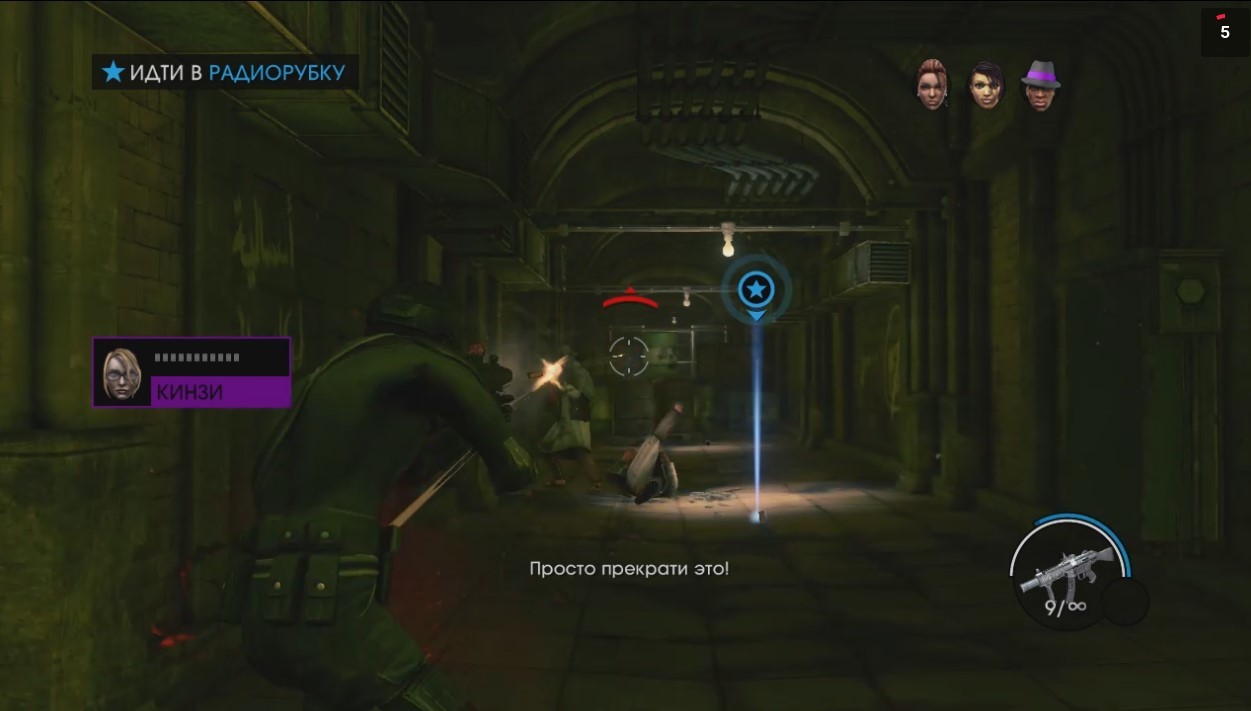
Screen shot of Saints Row 4 running on Playkey
If we compare the problems of Playkey in 2015 with the causes of OnLive bankruptcy in 2012, we can see the similarity of the sources of problems for both companies: they both did not have a well-thought-out business model, did not offer customers content that was in demand and both lacked a well-thought-out marketing strategy.
▍PlayStation Now
PlayStation Now is a game streaming service that allows you to play games for PlayStation 3 on a PC, mobile devices, TVs, PlayStation Vita, PlayStation 3, PlayStation 4. The service itself is the result of using technology and development from Gaikai, which Sony acquired in 2012 for $ 380 million. Officially launched as a subscription service in the United States on January 13, 2015.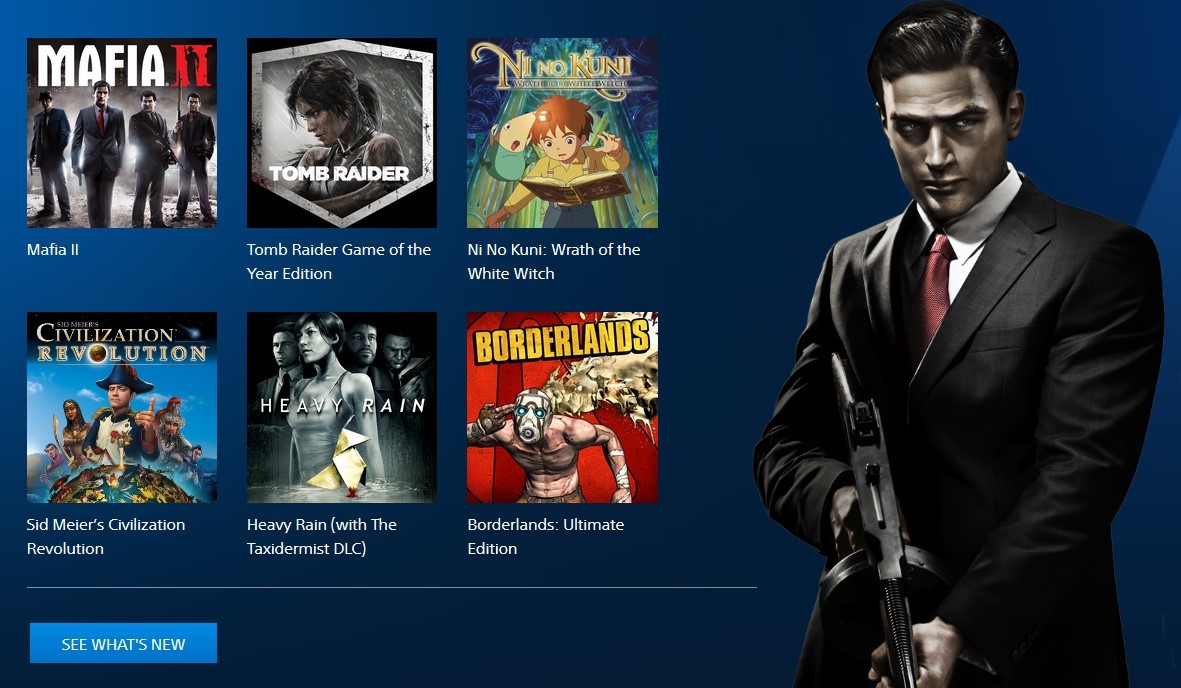
Screenshot from PlayStation Now
In August 2016, the first PlayStation Now for PC was launched in the UK, Belgium and the Netherlands. At the moment, the service provides access to more than 400 games released on the PS3. For new users, a seven-day free trial is available.
All you need to use is to download a special PlayStation Now application and connect DualShock 4 or another joystick. The service is not yet available in Russia, but some craftsmen have found ways to circumvent this restriction. You can see how they did it.
According to the latest data, the company has sold over 40 million PS4 consoles worldwide — a huge market for the company. However, the service has a problem, which is that in this service you can only play games for PS3. The reason for this lies in the technology used by Sony.
Because of the same features on PS4 consoles, it is impossible to play PS3 games without a cloud service, since These consoles are not fully compatible.
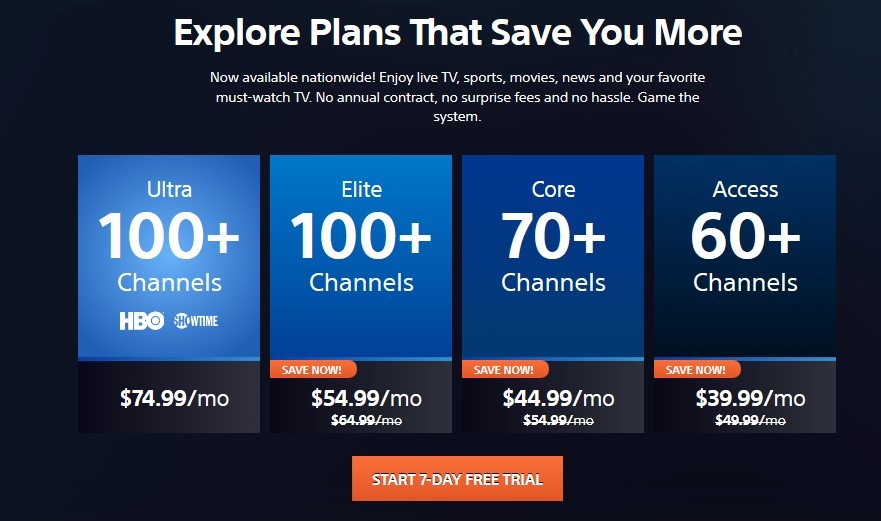
Discounts on PlayStation Vue
In addition, the Sony service is quite expensive - the PlayStation Now is the most expensive of the listed services and costs $ 20 for 1 month of subscription. And the pricing of their PlayStation Vue service for streaming video, to put it mildly, “surprised” me. For comparison, the Netflix service offers similar services in the US for $ 9.99 per month.
Services for consoles and TV
I have never used such services, perhaps, therefore I am a bit biased towards them. However, the GeForce NOW and GameFly projects are large emerging projects that I could not miss. They had to select a separate category. The picture below I took from the site Nvidia. It can hardly be called objective, but from it you can make a general idea about the services of GeForce NOW, PlayStation Now and GameFly.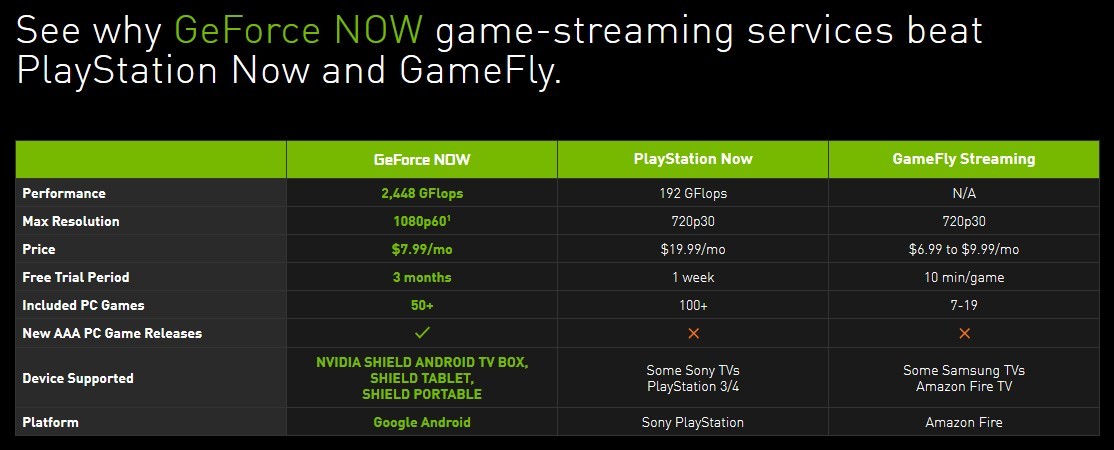
Comparison of services from the site Nividia
▍GameFly
Previously, the company's business was expressed in the figure below. As you can see from it, the company used to provide rental games. But time passed, and this model has already ceased to be competitive in the modern world.
Old GameFly Business Model
Therefore, in June 2015, it acquires the Israeli company Playcast Media Systems, and immediately launches a new service. The company changes its priorities and begins to look up to date.

Screenshot from GameFly website
At the moment, the main markets for the service are North America and Europe. According to the company, the number of service subscribers is about 334,000 people. To use it, you must be the owner of one of the smart TVs manufactured by LG, Samsung or Philips.
▍GeForce NOW
The GeForce NOW service allows you to play on Shield Portable, Shield Tablet, Shield Android TV by subscription. The service offers 3 months for free to customers of Shield series devices, and then a subscription payment for $ 7.99 per month is required. Most of the games are included in the subscription, but you have to pay for the rest.
Devices for using GeForce NOW
Could not find the number of subscribers to this service, but, according to the company, more than 100,000 people in 190 countries of the world participated in testing the service alone.
Small projects
▍Ubitus GameNow
Service is more dead than alive. The latest articles and tweets on this service of the Taiwanese company Ubitus refer to 2013. The service has a working site with games, but only a couple of them I was able to run after several attempts. I can not say that I have a great Internet, but my other services were launched without any problems.
Screenshot from Ubitus GameNow with King’s Bounty: The Legend
▍PlayGiga
Despite the start of the project in 2013, the final product was not presented to users. The company maintains a website where information is updated, but the project has not yet taken off. It is not even clear on which platforms they are going to work.▍Gface
From the series all ran, and I ran. It seems that the company Crytek, the creator of the service, did not fully understand what games are in the cloud, and made a forum for the players to communicate their game.▍Kalydo
On the Wikipedia page it is indicated that the service is operational, however, it seems that he quietly died in early 2016, or maybe earlier. It was a streaming service where you could start playing almost instantly after purchasing a game, and the rest of the data was downloaded as the game progressed.▍LoudPlay
The Russian project, which has not yet taken off. There is practically no information on the project site itself. There are several reviews on testing the service. The essence of the service is that the user rents a game server on which you can install any game. According to some information on the Internet, the service is dead, and its developers have evaporated.▍Playincloud
Also, the Russian project is very peculiar. According to the developer’s assurances, the service is not commercial, but there are tariffs for its use on the site. Players use the service in turn: one came in, the other came out. The server is preinstalled with games that users can play.▍Leap Computing
Has not taken off and already, maybe, and will not take off. The developers demonstrated the operation of the system under controlled conditions and on this the project stalled. The developers promised a year ago to provide a working version, but it's still there.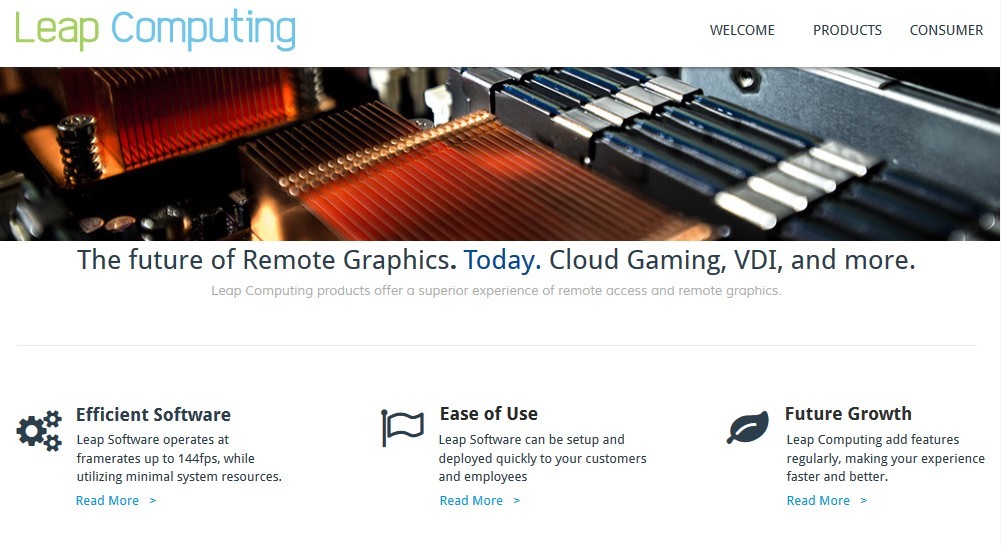
Screenshot from Leap Computing
▍Turbo.net
Service does not apply to games. As indicated by the developers of the service, it is designed for developers and IT managers and allows you to create a virtual space for developed applications.▍G-cluster
Initially, I believed the information on the Wikipedia page that the service stopped working, but this was not entirely true. Yes, G-cluster Global Corporation itself went bankrupt and was liquidated, but all of its assets, patents, etc. moved to its parent company Broadmedia Corporation, which continued to provide services for the provision of service. But the error on the page is clear, because I could not find a single assessment on english language, how does this service really work well?The service is a pioneer of streaming games and was created back in 2000, but it never became profitable, which caused the liquidation of the company. During all this time, did not become popular in the world. It seems that it is not very popular in Japan, the main market for this service, based on estimates in Google play. You can see the history and business model of this service for 2010.
▍ Others
There are other participants in the cloud games market, about which there is nothing in this article. For example, it marked Ubisoft Entertainment, Amazon, CiiNOW, GamingCloud, Google, Happy Cloud, IBM, Microsoft, Nintendo, Samsung Electronics, TransGaming, Valve (took this list from the analytical report of the company Technavio). As you can see in this list you can find almost all large companies in the field of electronics. Probably other companies offering network solutions like IaaS, PaaS or SaaS, could offer some product to end users, but so far there have been no such attempts.Comparison of the use of services Playkey and LiquidSky
For the Russians from the major services of games in the cloud, so far only these 2 specified projects are available. There are, for example, the Russian Playincloud or Ubitus GameNow, which you can also try to use, but they are either small or only partially functioning.For a visual comparison of these services, I used the game Europa Universalis 4, a computer game in the genre of a global strategy, which was developed by Paradox Interactive. Is not best game to compare these two systems, but its example is sufficient to illustrate the difference in operation between these two services:

As can be seen from the comparison of the services provided, both have their own advantages and disadvantages. For me personally, the LiquidSky service is more interesting, but the remoteness of the available servers negates all the advantages and does not allow using this service.
Pros and cons of games in the cloud for end users
The advantages and disadvantages of games in the cloud since OnLive and Gaikai did not change. However, with the development of technology, quality of communication and acquaintance of an increasing number of users with this technology, the priorities of these features change, i.e. how important they are to the user.Benefits

disadvantages
- Picture quality - the higher the picture quality, the more resources will be spent in the cloud and the higher will be the requirements for the bandwidth of the communication channel and its stability. Often there is a situation when cloud service providers compress the picture coming to the end users.
- Internet traffic - cloud services require the consumption of a large amount of traffic. At the same time, the Internet speed should be stable, at least 5 Mbit. Playing games in the cloud, the user can spend more than 3 GB of Internet per hour. With the improvement of the quality of the picture, the consumption of traffic increases proportionally. If game streaming becomes more common, network congestion will increase dramatically.

Picture quality in the cloud and on PC
- Delay - from which you can not get anywhere. The game will respond to player actions faster when it is running on the local computer.
- Copyright protection - publishers may prohibit or restrict the use of games in certain territories, set their prices or terms of use.
- The emergence of a monopolist - a situation may arise when a monopolist emerges on the market who can establish rules in the local market.
- Bankruptcy of the service or a change in terms of use - the situation with OnLive may repeat, when all purchased games and subscriptions just disappeared in 2015, when Sony bought all of the company's assets, but did not compensate for any obligations to users.
Technology
In 2009, when the OnLive and Gaikai services appeared, they showed that streaming games were possible. Prior to this, there was an opinion that this is impossible due to the high delay between the server and local computer: the information should be on networks to reach the server, there it should be processed, compressed and sent back to the client device.Companies used different approaches to solve this problem. The OnLive service focused on the hardware and developed its own video encoder. Their idea, according to this article, was to divide the stream into 16 rectangular sections and process each of these sections with a separate coder. Gaikai approached the problem with the help of existing hardware solutions, but using his software experience.

Own OnLive video coder
Today, there are 3 companies that own and use their own game streaming technologies: Nvidia, Sony and GameFly. Most of the remaining game streaming services use Nvidia technology.
Nvidia
Nvidia has developed nvidia technology Grid, which was announced in 2012. The company immediately announced that Nvidia Grid is not a gaming service, but a product that will be offered to operators of cloud gaming services. At that time, this solution was used by almost all start-ups in this area, including services Gaikai, Playcast, Ubitus, CiiNow and G-Cluster. Now this technology is used by LiquidSky and Playkey. On this The video shows the operation of Nvideo Grid for the end user.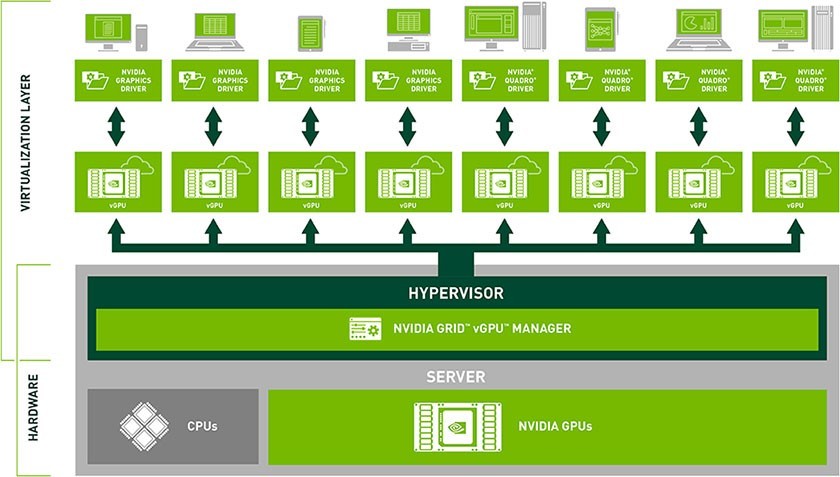
Job Description Nvidia GRID from Nvidia
The main element of Nvidia GRID is Nvidia GPU. On the Nvidia website, you can see the specifications and how it all works.
At the moment, the company offers its gaming service GeForce Now. To use it, you must have an Nvidia device: one of the devices in the Shield Portable, Shield Android TV or Shield Tablet product line.
Sony
In 2012, Sony acquired Gaikai. This allowed the company to create a PlayStation Now platform based on Gaikai technologies in 2014. In 2015, Sony 2015 acquired OnLive patents.The new division of Sony has received the task to develop technology that would allow to run PS3 games in the cloud for PS4, TVs, tablets and smartphones. At first they experimented with installing ordinary PS3 in data centers, but the experiment was not successful for obvious reasons. After that, Sony developed motherboardOn which the reduced components of eight PS3 consoles are installed, which can work independently. By placing such cards in data centers, Sony has created a PlayStation NOW service. The graphics processor used in this board was developed jointly by Sony and Nvidia 11 years ago based on the Nvidia GeForce 7 graphics processor.

PlayStation NOW motherboard
It is clear that because of this technology, the Playstation Now service can only work with games on the PlayStation 3.
Gamefly
In June 2015, GameFly acquired an Israeli company, Playcast Media Systems, which, it claims, offered its own “market ready and scalable” technology. This service is available on Amazon Fire TV and Samsung Smart TV devices. Compared to Nvidia and Sony, this company is much smaller, and previously Playcast used the Nvidia Grid in its operations. I most likely would not have added this company to this list if Nvidia would not consider the GameFly service as one of its main competitors for its own service. This is evident from the comparison of their services from the Nvidia site in an article earlier.
Existing companies in the market for streaming games with their own technology
Development and problems of the market
When the OnLive service appeared, it caused a stir. "The most powerful gaming system in the world" and "The Game Revolution" could have stumbled across the headlines of magazines and newspapers. In 2012, analysts shortly before his bankruptcy estimated its value at $ 1.8 billion. 4 years have passed since that moment, but it still remains difficult to predict the future of the game streaming market.Situation in the world
In its report on the development prospects of the cloud gaming services market for 2016-2020, Technavio predicts that the global market will grow by 29% per year. It seems to be excellent prospects for market participants, even ahead of 18% growth in the streaming video market, according to the company Markets and Markets.However, in retrospect, it is difficult to believe in the accuracy of this forecast. In the previous report, Technavio called G-Cluster, Nvidia and OnLive the main providers of gaming cloud services, of which 2 companies had already ceased their activities by this time.
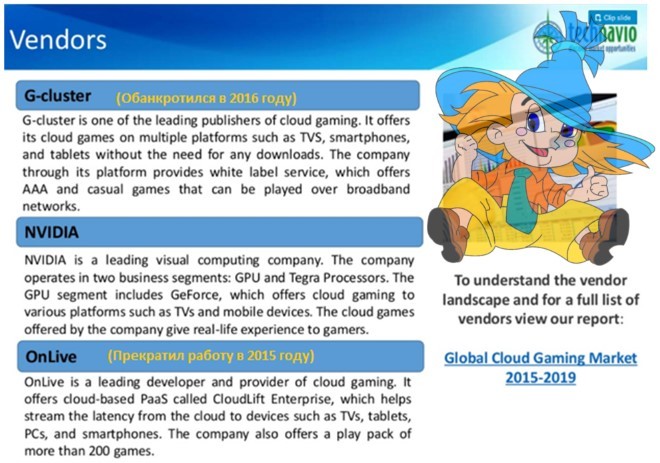
Picture from Technavio presentation (collage)
There is no doubt that the market for games in the cloud will continue to evolve, because The speed and quality of the Internet in the world is constantly growing, and large companies have begun to invest in projects of the cloud gaming services market, but at the same time the market remains risky.
There are several factors hindering the development of the cloud games market. Firstly, this is a delay in the transmission of a signal, from which it is impossible to completely get rid of. Unlike streaming video, where it is possible to use a memory buffer, this is not possible for games in the cloud.
The second problem is that large technology companies with well-established business of playing in the cloud are simply not needed. With the development of games in the cloud, the games market will be cannibalized physical media and falling computer equipment sales. Perhaps that is why neither Nvidia nor Sony are seeking to massively introduce these technologies for the end user and offer them only as a kind of fashionable chip for their devices and only mostly outdated games.
In the future, companies working in this area may face problems that have arisen from the world leader in streaming video, Netflix. According to the latest information, during 2012-2016, the catalog of films offered by the service has decreased by 2 times. The reason is the complexity and cost of rights to buy content and increased competition in the market. The same thing can happen in the market of gaming equipment, because when using the cloud it becomes unimportant what device the player uses.

Netflix main competitors
Problems for market participants may arise not only with game manufacturers, but also their distributors, for example, Steam, GOG.com or Origin services. Thus, under the terms of the Steam Subscriber Agreement, all buyers are subscribers, i.e. do not own the rights to the purchased games and in the case of liquidation, Steam may lose all the games. Such an event may have a negative impact on market prospects.
The situation in Russia
Research company Akamai Technologies has published the results of testing the speed of Internet access in different countries. In Russia, the average speed of access to the Internet increased by 29% compared with the previous year and amounted to 12.2 Mbit / s for the first quarter of 2016.
Picture from Russia Insider
According to the service representatives, the minimum bandwidth should be 5-15 Mbit / s for their use. However, this is only the minimum required speed, which I would have raised to at least 25 Mbit / s for comfortable use. For example, my provider gives me a 60 Mbps channel. Despite this, it often turns out that Playkey determines my poor quality of communication. Based on these estimates, if the same growth rate of the Internet speed is maintained in the near future, the required level of 25 Mbit / s in Russia will be reached in about 3 years.
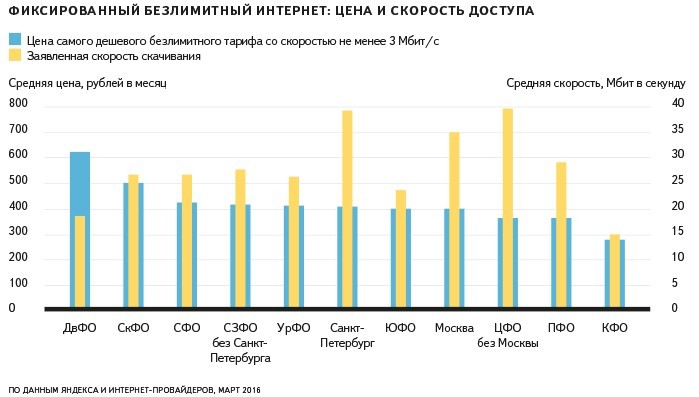
Picture from a study by Yandex
It seems that from the diagram above it follows that so far only in KFO and DFO the speed of the proposed Internet is significantly lower than the required 25 Mbit / s, but all is not so good. Just look at these reviews from one of the Internet providers offering speeds of 50 Mbit / s, like these: “Burn in hell”, “NOT FOR WHAT”, “Worse than where, deception”, etc. - and it becomes clear that these people are unlikely to become happy users of games in the cloud in the near future.
Conclusion
Over the past 7 years since the emergence of OnLive and Gaikai services, the industry has come a long way. At the moment, the market is growing rapidly and while companies do not have to push their elbows to attract players. But soon this may change, the market will become saturated and large companies will start a battle for end users.Despite the fact that many players have already managed to give up on games in the cloud due to the high cost of services, bad communication or outdated games, talking about games streaming technologies is no longer surprising. The necessary technologies already exist, the speed of the Internet connection is constantly growing, and companies offer players more and more advanced services.

Cloudy mario
After leaving OnLive and Gaikai services from the market, you should not put an end to games in the cloud. Business pioneers tend to have a hard time. There is no need to go far for examples. The leaders of the modern market in most areas are not at all their discoverers. Not Amazon was the first to sell books online - first was Books.com. Searching the Internet is not an idea for Google, but companies like AltaVista. Social networks do not owe their appearance to Facebook - MySpace was before. Add tags
In the early 2000s, cloud streaming services appeared, allowing you to play hard games over the Internet without downloading them. Yegor Guryev, CEO of Playkey, spoke about how cloud gaming is developing in different countries and what kind of future it holds in Russia.
The latest gaming industry news signals that world giants are closely looking at the "clouds". Recently, Microsoft officially announced the development of the DeLorean system, a game streaming technology that can predict the actions of gamers before pressing the keys of a keyboard or gamepad. Apparently, the company is preparing to submit its own streaming service, which will allow launching games for the Xbox One and Xbox 360 via a browser. This means that in a few years, when the technology is optimized, Sony will have a serious competitor with their PlayStation Now.
There were rumors that Google bought the platform and hired engineers from CiiNOW, who launched the cloud game service from the major operator Korea Telekom (KT). Official confirmation of the acquisition has not yet been, but experts are talking about the appearance on the market of a new major player.
The number of companies offering streaming games is growing worldwide.
So, cloud technology, or video streaming technology of games, allows you to start the game without installing anything, but only by connecting to a remote server using a browser. The user starts a game on his device, the program sends a signal to the server, authorizes it, selects the best server in the cloud for the user.
Each image that the game builds is captured, compressed into a video stream and sent to the client application, which only needs to display it to the user. As you can see, everything is simple: the game starts on the server, and the user receives only a video stream of 5-10 Mbit / s.
And now about how cloud gaming services are presented in the global market.
America
The company OnLive can rightly be called the pioneer in the field of cloud games. The first mention of OnLive takes us back to 2003. But the public announcement took place only in 2009 - at the GDC exhibition in San Francisco. OnLive promised console for $ 100, not more, and in some cases, and $ 50. They have fulfilled their promise. In 2011, I myself bought such a prefix on their website for $ 99.
During 2010-2011, OnLive signed contracts with major publishers of PC games: Square Enix, THQ, Ubisoft, Warner, CD Project. However, publishers are not in a hurry to give their new products to the cloud technology. At the same time, skeptic comments from copyright holders, in particular, Crytek, claim that they “do not believe in the success of cloud games” are starting to appear, because the existing networks of operators are not prepared for Сloud Gaming, so it’s worth waiting until 2013-2015 ( It seems that the time of the "clouds" has come).
In February 2012, OnLive reports about attracting an investment of $ 40 million from the largest manufacturer of electronic equipment HTC. Attracting copyright holders, Onlive simultaneously launches an application for Smart TV.
And suddenly, like a bolt from the blue, the news is heard on August 23, 2012: OnLive is recognized as an insolvent company with debts of $ 30-40 million. The company is changing its shareholder, Lauder Partners LLC becomes the new owner under the leadership of Gary Lauder, a well-known venture capitalist .
Today OnLive has changed the business model, has gone on to integrate with Steam and is trying to restart its product in a new concept.
Asia
Almost simultaneously with OnLive, Gaikai appeared on the market, its founder - David Perry, a well-known personality in the gaming industry, the ideologist of a number of games, including MDK, Earthworm Jim, Messiah.
In 2012, Sony, which until then had harshly criticized OnLive, acquires Gaikai for $ 380 million to develop its own streaming service, PlayStation Now. It allows you to broadcast games not only on the PlayStation 4, PlayStation 3 and PlayStation Vita, but also on TVs, tablets and smartphones. The service was officially introduced in January 2014, and at the same time the company launched its closed testing in the United States. In July, an open beta was launched for Americans, and the platform will come to Europe in 2015.

Koreans CiiNOW first launched gaming streaming service in KT (Korean Telekom). It seems not particularly successful, judging by the minimum marketing activities. The number of users has barely exceeded 5,000 real paying customers. The company provided the service and how the White Label solution for telecom operators. Any operator could use their corporate colors and logo using the CiiNOW platform.
In the summer of 2014, this company ceased to exist, recognizing the impossibility of recouping its costs. According to unofficial data, it was partially acquired by Google. Indirect confirmation - the status of key employees in social networks: for example, Devendra Rauth, VP of Engineering at CiiNOW, has moved to the position of Tech Biz Dev in Google.
Europe
In Europe, cloud services are represented by companies such as G-cluster Global and Playcast. The first - the leader in profitability in the world of "cloud" games. Finns launched the project in 2000, focusing on cooperation with the world's largest IPTV operators - Orange (France), SFR (France), NTT Plala (Japan), Cox (USA). We do not yet observe our own services in Smart TV and PC.
The service of the Israeli company Playcast Media System was announced on July 21, 2009, and on the same day its pilot launch began. Playcast concentrated on large screens and launched its service on Amazon Fire TV on OUYA set-top boxes.
Russia
Well, in Russia, the game in the clouds took the company Playkey.
Since 2012, playkey.net, is open for beta testing. Servers are located in Moscow and Perm. Every day about 5 thousand unique users play on the service. 60% of users play from Russia, 25% from Ukraine, there are users from Belarus, Kazakhstan, Latvia, Romania, Azerbaijan, Georgia, Lithuania, Moldova. Session time is an average of 35 minutes.
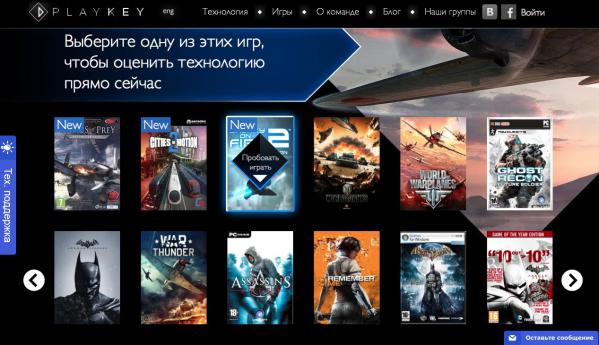
Playkey was created for those who do not want or do not have the opportunity to invest a lot of money in gaming entertainment. 80% of the audience are young people under the age of 25, mostly schoolchildren and students. In the future, we will also attract a family audience, those who play from time to time for entertainment. In this regard, we count on users of digital cable TV. So, we are already in the final stage of integrating our gaming service into the prefix "Dom.ru TV" of the second generation.
In addition to a large catalog of games, another competitive advantage to which we aspire is cross-platform. The service already works on Windows and MacOS, in 2015 we plan to connect Linux and Android. We are also developing our own PlaykeyBox, which can be played on the big screen.




